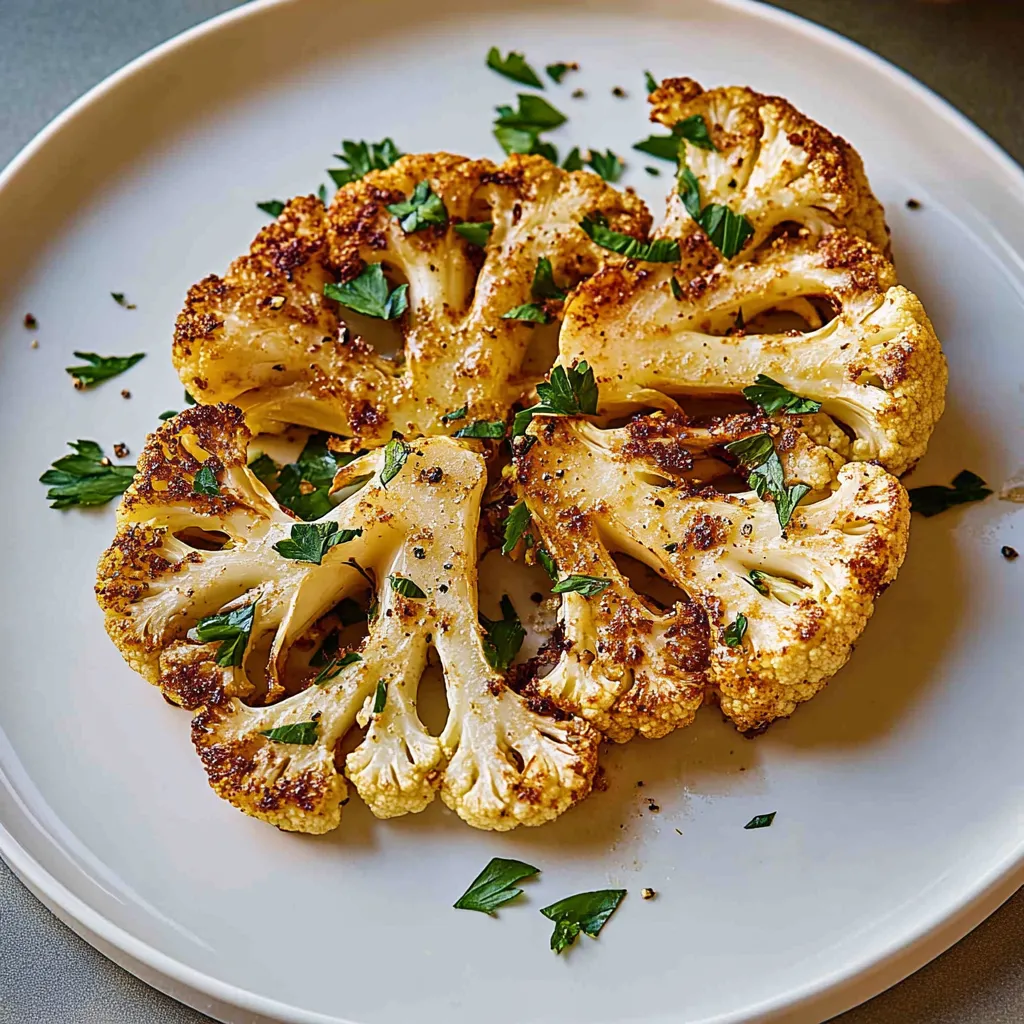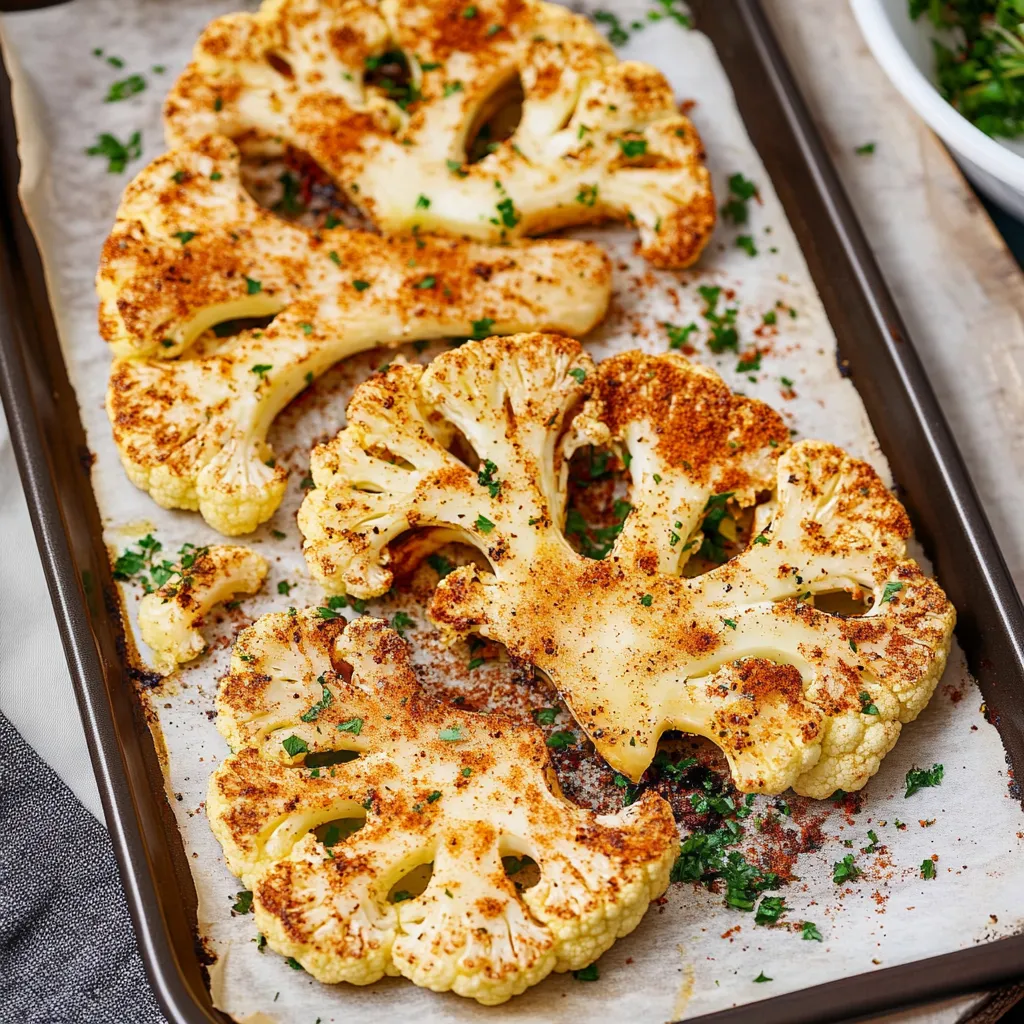 Pin it
Pin it
These impressive cauliflower steaks transform humble cauliflower into a substantial, satisfying main course that delivers the hearty, meaty experience that vegetarians and meat-eaters alike crave. The genius technique of slicing thick, intact "steaks" from whole cauliflower heads creates dramatic presentation while the high-heat roasting caramelizes the surfaces to golden perfection, developing deep, complex flavors that rival any traditional protein. Unlike complicated vegetarian dishes that require exotic ingredients or multiple components, this simple preparation showcases cauliflower's natural ability to absorb seasonings while developing its own robust, nutty character through proper cooking technique.
I created this recipe when I wanted to serve vegetarians something that felt like a proper main course rather than just vegetables on the side. The first time I made these, even my most dedicated meat-eating friends were amazed by how satisfying and flavorful they were, and now I regularly serve these as the centerpiece of meatless meals that leave everyone completely satisfied.
Essential Ingredients and Selection Tips
- Fresh cauliflower heads: Choose heavy, compact heads with bright white florets and fresh green leaves; avoid any with brown spots or soft areas
- Quality olive oil: Extra virgin olive oil provides the best flavor for roasting; spray bottles offer even coverage but brush-on oil works equally well
- Kosher salt: The larger crystals distribute more evenly and provide better seasoning control than fine table salt
- Fresh spices: Use recently purchased garlic powder, paprika, and coriander for maximum flavor impact; old spices lose potency quickly
- Smoked paprika option: This variation adds incredible depth and complexity that makes the cauliflower taste almost bacon-like
- Aged balsamic vinegar: For the balsamic variation, use quality aged balsamic that will caramelize beautifully during roasting
The secret to perfect cauliflower steaks is keeping the core intact during slicing - this structural foundation prevents the steaks from falling apart during cooking.
Detailed Step-by-Step Instructions
- Step 1: Prepare your oven and equipment:
- Preheat the oven to 425°F and lightly grease a large rimmed baking sheet with olive oil or cooking spray. This high temperature is crucial for proper caramelization.
- Step 2: Clean and prep the cauliflower:
- Remove the outer leaves from both cauliflower heads and trim just the very bottom of the stem, but leave the core completely intact. This core acts as the structural foundation that holds your steaks together.
- Step 3: Slice into steaks:
- Using a large, sharp knife, slice each cauliflower head vertically into ¾-inch thick slabs. Cut from top to bottom, keeping the core in each slice. You should get about 3 intact steaks per head, with some outer pieces naturally falling into florets.
- Step 4: Arrange for roasting:
- Place the intact cauliflower steaks in a single layer on the prepared baking sheet, then scatter any loose florets around them. Don't overcrowd - use two baking sheets if necessary for proper browning.
- Step 5: First seasoning application:
- Spray or brush the top surfaces with olive oil, ensuring even coverage. Sprinkle with half of your seasoning mixture (salt, pepper, garlic powder, paprika, and coriander), distributing evenly across all pieces.
- Step 6: Initial roasting phase:
- Roast for 15 minutes until the tops begin to turn golden brown and the edges start caramelizing. The cauliflower should be starting to soften but still hold its shape.
- Step 7: Flip and season again:
- Carefully flip each steak using a wide spatula, supporting the structure to prevent breaking. Spray or brush the newly exposed surfaces with oil and season with the remaining spice mixture.
- Step 8: Complete the cooking:
- Return to the oven for 10-15 more minutes until both sides are golden brown and the cauliflower is fork-tender throughout. The edges should be deeply caramelized and slightly crispy.
- Step 9: Rest before serving:
- Allow the steaks to rest for 2-3 minutes after removing from the oven. This helps them set slightly and makes them easier to transfer to serving plates.
 Pin it
Pin it
The most important technique is maintaining high heat throughout cooking - this creates the caramelization that transforms mild cauliflower into something rich and complex.
These cauliflower steaks have become my proof that vegetarian cooking can be just as satisfying and impressive as any meat-based dish. My teenage son, who typically demands meat at every meal, actually requests these regularly because he says they're "way more interesting than regular vegetables."
Understanding Cauliflower Structure and Cutting Technique
Successful cauliflower steaks depend entirely on understanding the vegetable's natural structure. The dense core that many people discard is actually the key to creating intact steaks that hold together during cooking. When you slice through this core, it acts like a natural foundation that keeps the florets connected. The ¾-inch thickness provides the perfect balance - thick enough to maintain structure while thin enough to cook evenly throughout.
Heat Management and Caramelization Science
The 425°F temperature is specifically chosen to promote rapid surface caramelization while cooking the interior properly. At lower temperatures, cauliflower steams rather than roasts, resulting in pale, soft vegetables without the complex flavors that high-heat cooking develops. The Maillard reaction that occurs at these temperatures creates hundreds of new flavor compounds that transform the mild, slightly sulfurous raw cauliflower into something nutty, sweet, and deeply savory.
Seasoning Penetration and Flavor Development
The two-stage seasoning process ensures maximum flavor penetration and even distribution. Oil applied before seasoning helps spices adhere and prevents burning, while the flip-and-season technique ensures both sides develop equal flavor. Garlic powder works better than fresh garlic because it distributes evenly and won't burn at high temperatures, while the combination of warm and smoky spices complements cauliflower's natural nuttiness.
Texture Contrast and Cooking Indicators
Perfect cauliflower steaks achieve the ideal balance between caramelized exterior and tender interior. The outside should be golden brown with slightly crispy edges, while the inside remains tender enough to cut with a fork but not mushy. Visual cues include deep browning around the edges, slight shrinkage as moisture evaporates, and a fork that penetrates easily without meeting resistance.
Versatility and Flavor Variations
This base technique works with numerous flavor profiles because cauliflower's mild nature readily absorbs whatever seasonings you apply. The balsamic variation creates sweet-tangy complexity as the vinegar reduces and caramelizes, while herb variations like thyme or rosemary add Mediterranean character. Understanding this adaptability allows you to customize the dish to complement any cuisine or dietary preference.
These cauliflower steaks have taught me that the most successful vegetarian dishes aren't trying to imitate meat but rather celebrating vegetables in ways that make them genuinely exciting and satisfying on their own terms. Every time I make them, I'm reminded that understanding proper technique - maintaining structure through smart cutting, developing flavors through high-heat caramelization - allows you to transform simple ingredients into dishes that stand proudly as the centerpiece of any meal.
Frequently Asked Questions
- → How thick should I cut the cauliflower steaks?
- Cut them about ¾-inch thick. This gives you the perfect balance of crispy edges and tender centers.
- → What if my cauliflower falls apart when I slice it?
- That's totally normal! Just roast the broken pieces as florets alongside your intact steaks.
- → Can I make these without olive oil spray?
- Yes, you can brush them with regular olive oil or melted butter instead of using spray.
- → How do I know when they're done cooking?
- They should be golden brown on both sides and easily pierced with a fork when ready.
- → Can I prep these ahead of time?
- You can cut and season them a few hours early, but they're best baked fresh for the crispiest texture.
- → What goes well with cauliflower steaks?
- They pair great with grilled chicken, fish, or as part of a vegetarian dinner with rice or quinoa.
